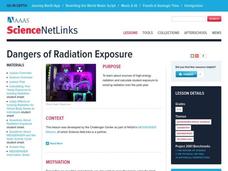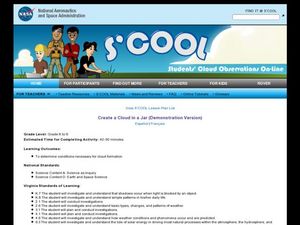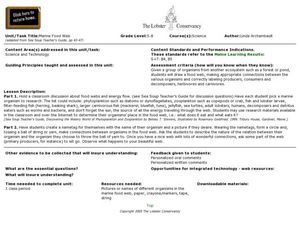Curated OER
Candy Reaction
In this triboluminescence worksheet, students use wint-o-green Lifesavers to observe a chemical reaction that gives off light. They break a lifesaver up with a hammer and make observations and they chew a lifesaver and make observations....
Curated OER
Wetland Food Webs
Middle schoolers study life science. In this food webs and food chains comparison instructional activity, students examine the wetlands to discover the relationships that exist between the animals that live there. They participate in...
Curated OER
Electrical Circuits
Students compare series and parallel circuits. For this electricity and circuits lesson, students roleplay as a "wire" passing an energy ball to demonstrate how a series circuit works and how the circuit can be broken. Students construct...
Curated OER
Dangers of Radiation Exposure
High schoolers calculate their yearly exposure rate to harmful high-energy radiation and cumulative effects over time. They use the information to evaluate the various sources of radiation that are of greatest concern for them.
Curated OER
GLOBAL WARMING
Learners form definitions of the greenhouse effect based on prior knowledge, class discussion, viewing diagrams, and participate in group brainstorming sessions and class discussions related to the impact of the greenhouse effect and...
Curated OER
The Carbon Cycle
In this carbon cycle worksheet, learners will read about the carbon cycle and study a diagram showing what creates carbon dioxide and what uses carbon dioxide. Students will then complete 4 short answer questions.
Curated OER
GROWING PLANTS UNIT
Students predict outcomes of scientific experiment,.conduct a scientific experiment with control groups, and plant seeds to observe, measure, and compare growth across groups. They gather, record, analyze, and share data with other...
Curated OER
Acceleration, Drag, Gravity, Motion, Forces, and Friction
Eighth graders build and run mousetrap cars in order to measure distance, time, and mass for their cars. They use these measurements to calculate average speed and kinetic energy, then create a slide show to visually explain how the car...
Curated OER
Conditions at Sea
Young scholars examine wave formation. In this wave lesson, students discover how waves are formed and how the weather at sea is predicted. Young scholars study ocean vocabulary and understand the Beaufort Wind Force Scale.
Curated OER
Studying Photosynthesis
In this photosynthesis worksheet, students conduct an experiment to show the making of starch in a plant's leaves during photosynthesis. Students complete 2 short answer questions.
Curated OER
Climate And the Greenhouse Effect
Young scholars demonstrate the greenhouse effect. They recognize that relatively small changes to our environment can stimulate significant climate changes. They determine that the "scientific method" is a process of testing hypotheses...
Curated OER
This Can't be a Plant
Students grow mold. In this science experiment instructional activity, students grow mold on different pieces of bread by adjusting the moisture, temperature, and light. They record the results to see which grows the most mold.
Curated OER
Weather, Sea Level Rise and Climate Change Course
Students explain the impact of glacial melting to global climate change. In this environmental science lesson, students design an experiment to investigate the effect of salinity change to melting glaciers. They share their results to...
Curated OER
Food Chain
Students participate in a simulation of the food chain. In this animal diet instructional activity, the teacher introduces students to the food chain, then assigns each student a part of the food chain to represent. The sun begins...
Curated OER
Create a Cloud in a Bottle
Young scholars look at how clouds form. For this cloud lesson, students make a cloud using water, 2 liter bottles and a match. They watch how the pressure and temperature changes the atmosphere in the bottle to create a cloud.
Curated OER
Create a Cloud In a Jar
Students investigate cloud formation. In this weather instructional activity, students examine how clouds are formed. Students participate in experiments that model how water vapor in the air works.
Curated OER
The Wind & Sun: Powerful Alternatives
Students examine the power that is possible from the sun through an interactive program. They also analyze how energy turns into different forms in different parts of the human body. They finally explore how wind is created and how wind...
Curated OER
Nitrogen Cycle
Students identify the main concepts and ideas of the nitrogen cycle.
They review key concepts covered up to this point in ecology including food chains, food webs, energy pyramids, and bio-geochemical cycles.
Curated OER
How a Liquid Changes to a Gas
Second graders identify three forms of matter- solids, liquids, and gases with 100% accuracy. They observe water evaporating from an open container and water evaporating and condensing in a closed container. The students assess that a...
Curated OER
Microclimates of Our School
Students read the story "Weslandia" by Paul Fleischman, define the term microclimate, gather and record data in various places on school grounds to establish the presence of difference microclimates, analyze and compare microclimates,...
Curated OER
Enthalpy Calculation Worksheet
In this enthalpy worksheet, students calculate the combustion for propane and find the enthalpy of the reaction. They discuss entropy and free energy.
Curated OER
Marine Food Web
Students investigate the effects of the food chain on all animals by creating a food web. In this seafood lesson, students discuss energy flow and research a specific marine organism of their choice. Students create a food...
Curated OER
Corals & Coral Reefs
Students describe a coral reef, how it is formed and its inhabitants. They explain the ecological and economic importance of coral reefs and discuss its present-day threats. Lesson contains adaptations for all levels.
Curated OER
Acid Rain
In this acid rain worksheet students complete a series of questions on acidity and how acid rain forms. Students view a slide show and list what they can do to help.

























